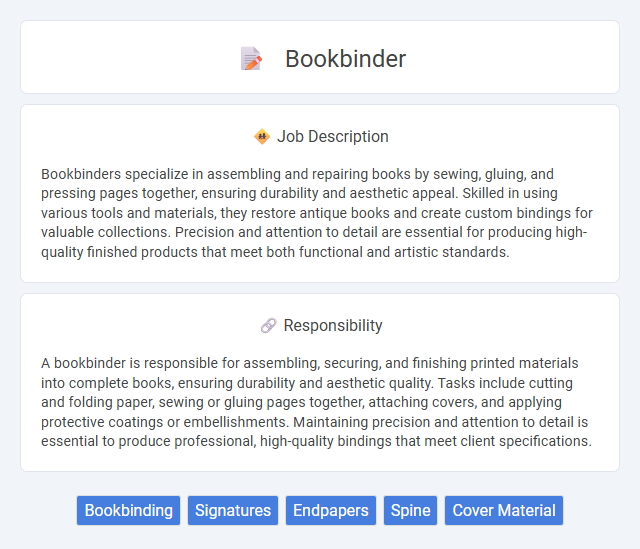
Bookbinders specialize in assembling and repairing books by sewing, gluing, and pressing pages together, ensuring durability and aesthetic appeal. Skilled in using various tools and materials, they restore antique books and create custom bindings for valuable collections. Precision and attention to detail are essential for producing high-quality finished products that meet both functional and artistic standards.
Bookbinding may suit individuals who have strong attention to detail and patience, as the job requires precision and careful handling of materials. People who prefer physical, hands-on work and enjoy crafting could find satisfaction in this role, while those who are easily frustrated or have limited manual dexterity might struggle. It is probable that candidates with good hand-eye coordination and an appreciation for preserving books will adapt well to the demands of bookbinding.
Qualification
A skilled bookbinder typically requires proficiency in handling various binding materials such as leather, cloth, and paper, combined with a strong understanding of book construction techniques. Attention to detail, manual dexterity, and experience with both traditional hand-binding methods and modern machinery are essential qualifications. Certification programs or apprenticeships in bookbinding can enhance expertise and improve job prospects in this specialized craft.
Responsibility
A bookbinder is responsible for assembling, securing, and finishing printed materials into complete books, ensuring durability and aesthetic quality. Tasks include cutting and folding paper, sewing or gluing pages together, attaching covers, and applying protective coatings or embellishments. Maintaining precision and attention to detail is essential to produce professional, high-quality bindings that meet client specifications.
Benefit
Bookbinder jobs likely offer benefits such as enhancing fine motor skills and attention to detail, which can improve overall craftsmanship quality. There is a probability of gaining satisfaction from preserving and restoring important documents, thereby contributing to historical conservation. These roles may also provide steady employment in specialized artisan fields with opportunities for skill development and career advancement.
Challenge
Bookbinder jobs likely present challenges related to precision and attention to detail, as securely assembling and repairing books requires meticulous craftsmanship. The need to maintain durability while preserving the aesthetic quality of each volume may pose ongoing difficulties. Handling various materials and adapting to different book types could increase the complexity and learning curve of the role.
Career Advancement
Bookbinders can progress from entry-level roles to specialized positions such as restoration expert, quality control supervisor, or production manager. Developing expertise in advanced techniques like leather binding, gold tooling, and digital binding technology enhances promotion prospects. Successful career advancement often involves continuous training in preservation methods and mastering innovative materials to meet industry demands.
Key Terms
Bookbinding
Bookbinding involves assembling sheets of paper into a secure, finished book through techniques such as sewing, gluing, and casing-in. Skilled bookbinders utilize specialty tools like presses, cutters, and bone folders to ensure precise alignment and durability. Materials such as leather, cloth, and paperboards are expertly crafted to create protective and aesthetically pleasing book covers that enhance longevity.
Signatures
Bookbinder jobs require precise handling of signatures, which are groups of folded sheets assembled in a specific order to form the backbone of a book. Accurate stitching or sewing of signatures ensures the durability and proper alignment of the book's pages, preventing misprints and damage. Mastery in folding, collating, and binding signatures is essential to maintain the structural integrity and aesthetic quality of finished books.
Endpapers
Endpapers are a crucial component in the bookbinding process, serving as the double leaves that connect the book block to the cover while providing structural support and aesthetic appeal. Bookbinders carefully select and attach endpapers using adhesive or sewing techniques to ensure durability and enhance the book's overall presentation. High-quality endpapers often feature decorative patterns or acid-free materials, contributing to the preservation and longevity of the book.
Spine
The spine of a bookbinder's work is crucial for durability and aesthetic appeal, involving precise measurements and strong adhesive applications to ensure pages are securely bound. High-quality materials like linen or leather are often used to reinforce the spine, providing flexibility and longevity. Mastery in spine shaping and finishing directly impacts the book's usability and overall presentation in the market.
Cover Material
Bookbinders select durable cover materials such as leather, cloth, or synthetic fabrics to enhance the book's longevity and aesthetic appeal. High-quality cover materials are essential for protecting the book's interior pages from wear, moisture, and environmental damage. Specialty cover materials can also provide unique textures and finishes, increasing the book's value and consumer appeal.
 kuljobs.com
kuljobs.com